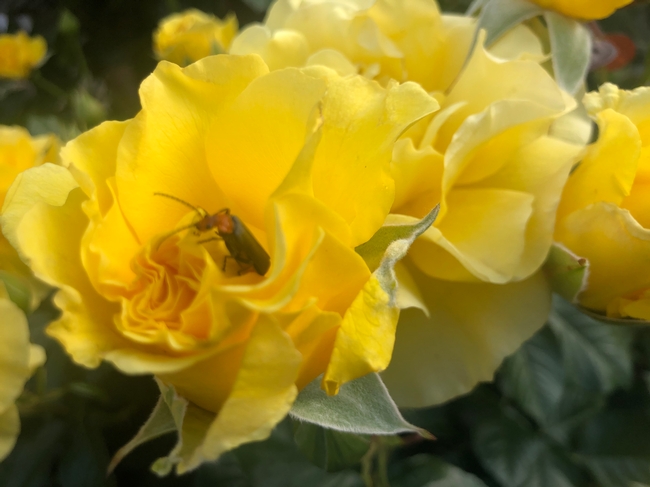- Author: Kathy Keatley Garvey
The Red Coats are coming. The Red Coats are coming.
No, not an army of soldiers. Soldier beetles.
These insects (family Cantharida) resemble the uniforms of the British soldiers of the American Revolution, which is apparently how their name originated. They're also called "leatherwings" in reference to their leatherylike wing covers.
Soldier beetles are beneficial insects; they're the good guys and gals in the garden. The adults eat scores of aphids. In addition, they are pollinators. So, don't even think of killing soldier beetles. Enlist them in your garden to feast on aphids.
"The adults are long and narrow," according to the UC Statewide Integrated Pest Management Program (UC IPM), which labels them as natural enemies of garden pests. "Common species are often about 1/2 inch (13 mm) long with a red, orange or yellow head and abdomen and black, gray or brown soft wing covers. Adults are often observed feeding on aphids or on pollen or nectar on flowering shrubs and trees. Metamorphosis is complete. Larvae are dark, elongate, and flattened. They feed under bark or in soil or litter, primarily on eggs and larvae of beetles, butterflies, moths, and other insects. There are over 100 species of soldier beetles in California."
If you want to know identify some of the natural enemies of garden pests, you can download UC IPM's educational poster, "Meet the Beneficials: Natural Enemies of Gardens" here.
The poster illustrates some of the beneficial insects, mites and spiders that prey on garden pests:
- Convergent lady beetle
(adult, larva, eggs) - Green lacewing
(adult, larva, eggs) - Predaceous ground beetle
(adult, larva) - Assassin bug
- Pirate bug
- Damsel bug
- Soldier beetle
- Spiders
- Syrphid fly
(adult, larva) - Sixspotted thrips
- Western predatory mites
- Predatory wasps
- Praying mantids
- Examples of parasites (including a typical life cycle)
These soldier beetles may even know how to pull rank.
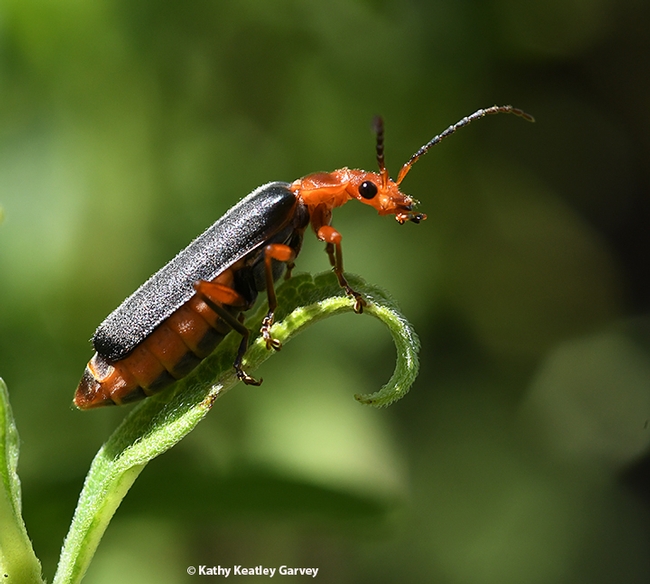
- Author: Kathy Keatley Garvey

Take that, you aphids! That'll teach you to suck the lifeblood out of my plants!
"Aphids are small, soft-bodied insects with long slender mouthparts that they use to pierce stems, leaves, and other tender plant parts and suck out fluids," according to the UC Statewide Integrated Pest Management website on how to manage aphids. "Almost every plant has one or more aphid species that occasionally feed on it."
Aphids are major agricultural and garden pests. What's it like to be an aphid? How much stress can they handle?
Enter postdoctoral scholar Jessica Kansman of the Department of Entomology, Pennsylvania State University. She's the next speaker in the UC Davis Department of Entomology and Nematology's winter seminar series. She'll speak on "To Be an Aphid in a Cruel World: How Abiotic and Biotic Stressors Influence Plant-Insect Interactions" from 4:10 to 5 p.m., Wednesday, Feb. 24. To register and attend the Zoom seminar, access this Google form link.
"Whether it is combating the ever-changing host-plant conditions, or keeping careful watch for hungry predators and parasites--aphids have a stressful experience," Kansman says in her abstract. "My research has focused on figuring out just how much stress aphids can handle. Specifically, how plant water stress influences aphids and their natural enemies, and whether predator odors are as stressful for aphids as the predators themselves."
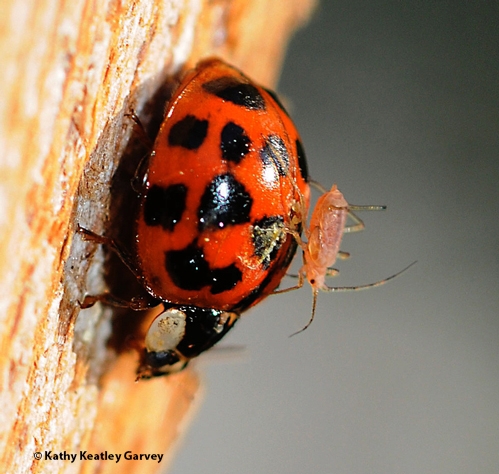
Kansman holds a bachelor's degree in entomology (2015) from Michigan State University, East Lansing, and a doctorate in plant, insect and microbial sciences (2020) from the University of Missouri, studying with Deborah Finke. As a doctoral student, she received a $116,859 grant from the U.S. Department of Agriculture "to study the effect of drought on aphid performance and behavior, indirect effects of drought on natural enemies, and how these effects cascade up to influence insect communities." The Agriculture and Food Research Initiative (AFRI) of USDA's National Institute of Food and Agriculture (NIFA) awarded the grant.
Kansman has given such presentations as "Plants vs. Insects: A Tale of Spines, Spit and Assassins." In one YouTube video on "Decoding Science," she describes aphids as "devastating agricultural pests. They feed by piercing a needlelike mouthpart into the plant tissue and they use it as a straw to suck up the sap of the plant." Aphids stunt growth and transmit viruses.
Cooperative Extension specialist Ian Grettenberg is the seminar host and coordinates the seminars. For technical issues, he may be reached at imgrettenberger@udavis.edu.
For a list of Department of Entomology and Nematology seminars, click here.
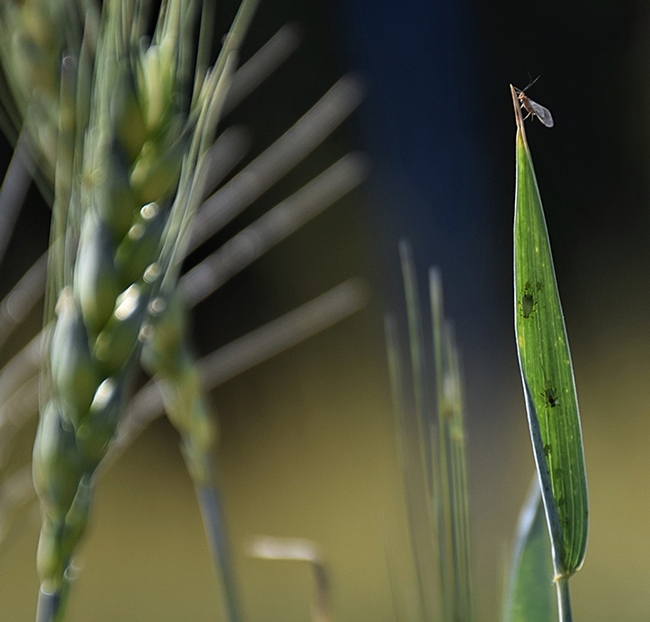
- Author: Kathy Keatley Garvey
You never know about those photo-bombers. You can't trust 'em.
So here I was, trying to photograph a tiny egg that a monarch butterfly had just deposited on our milkweed.
I held it up for a better look.
And then, the photo-bomber!
An oleander aphid, Aphis nerii, appeared out of nowhere and headed over to the egg for a quick "inspection."
Oleander aphids suck the juices, the very lifeblood, out of milkweed plants. They're yellow with black cornicles, they're non-native, and they're pests on milkweed when all you want are guests! (Like monarchs)
Want to know more about these pests? Check out the UC Statewide Integrated Pest Management Program's website on aphids.
"Aphids are small, soft-bodied insects with long slender mouthparts that they use to pierce stems, leaves, and other tender plant parts and suck out fluids," UC IPM says. "Almost every plant has one or more aphid species that occasionally feed on it."
They are also quite good at photo-bombing. Trust me.
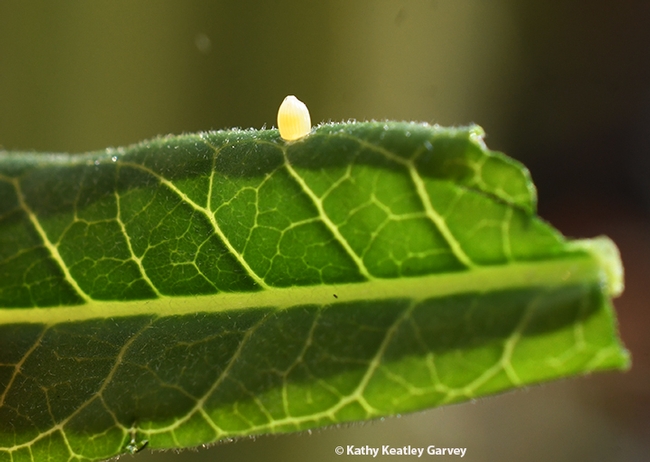
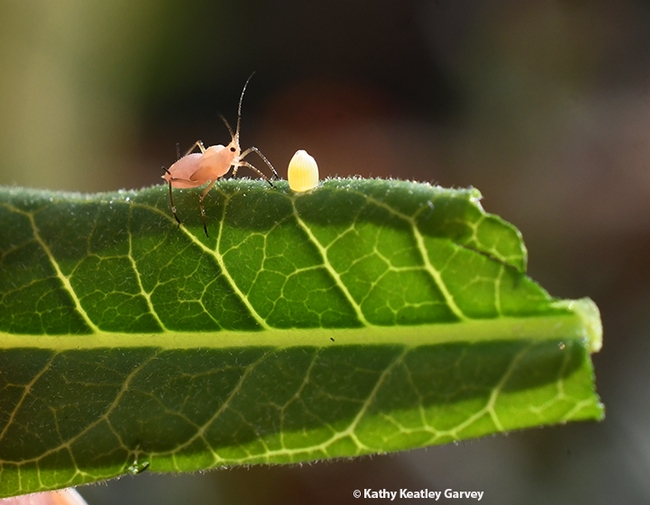
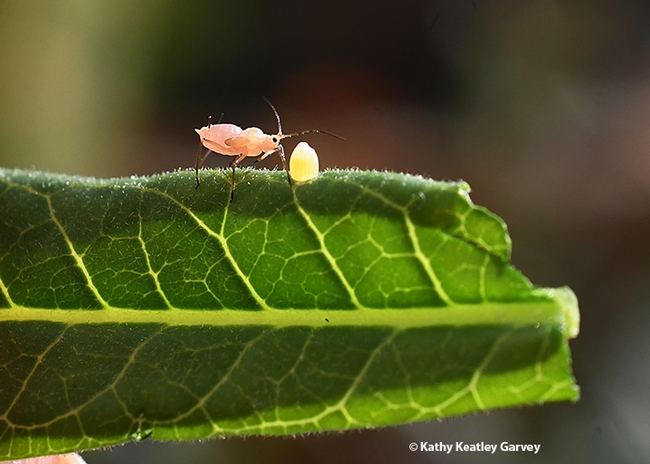
- Author: Kathy Keatley Garvey

Monarchs lay their eggs on the underside of milkweed leaves--generally--but we've seen them on stems and on the leaf edges. They usually deposit a single egg beneath the leaf, but we've spotted as many as four on one leaf. They secrete a glue so the egg will adhere.
Color? They're a creamy yellow with narrow longitudinal ridges from the top to the bottom. Size? About 0.9 to 1.2 mm long, or about the size of a pinhead.
They hatch about 3 to 4 days after they're laid. Then you'll see the black-headed tiny larva or caterpillar eating its shell before it begins devouring the leaf.
Some folks confuse the sap-sucking yellow oleander aphids with the monarch eggs. Or the yellow eggs of the lady beetle, aka ladybug. So we took a few images of them.
In our family pollinator garden in Vacaville, we've collected about 250 monarch eggs or caterpillars this year, and the mamas are still laying eggs! We're not the only ones who like monarchs. We try to collect the eggs before the predators and parasitoids get them. Predators include lady beetles (ladybugs), spiders, milkweed bugs, lacewings, and wasps. Tachinid flies and other parasitoids lay their eggs in or on the immature monarchs or deposit their eggs on a leaf that the caterpillar eats. The fly larvae develop inside the living host, killing it. Note: tachinid flies are considered beneficial insects when they lay their eggs in such pests as cabbageworms.
We grow five species of milkweed:
- Tropical: Asclepias curassavica
- Narrowleaf: Asclepias fascicularis
- Showy: Asclepias speciosa
- Butterfly weed: Asclepias tuberosa
- Swamp milkweed: Asclepias incarnata
But back to the question: how can you tell the difference between an oleander aphid and a monarch egg? They are so tiny and both are yellow! Basically, the aphid has legs and it moves! Some aphids are winged and fly. Another clue: aphids cluster together; you won't find monarch eggs in a cluster.
Note that the lady beetle lays her eggs in clusters, so if you find a cluster of eggs, those aren't monarch eggs.
Happy hunting!
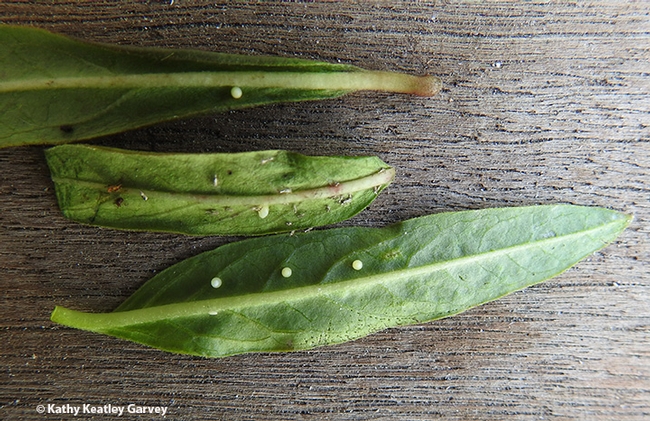
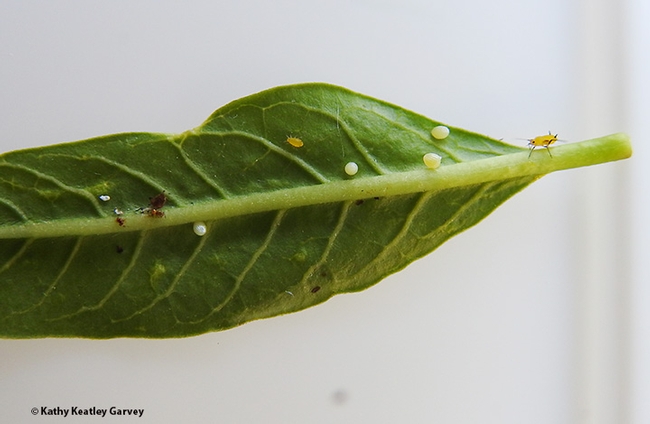
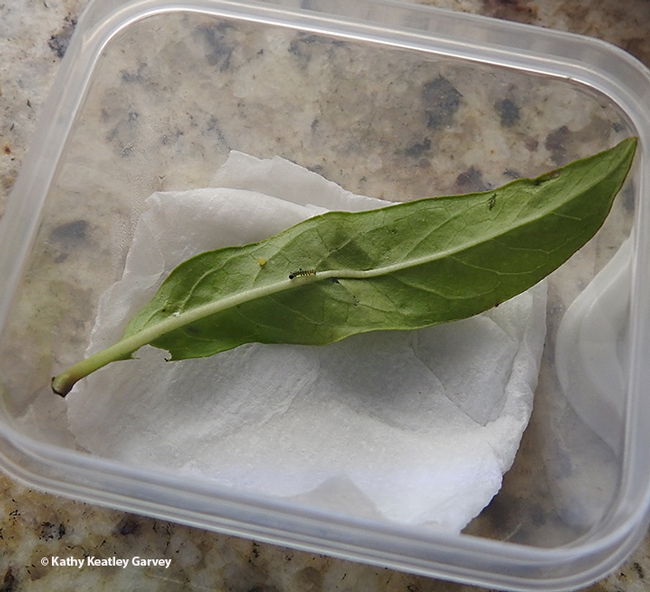
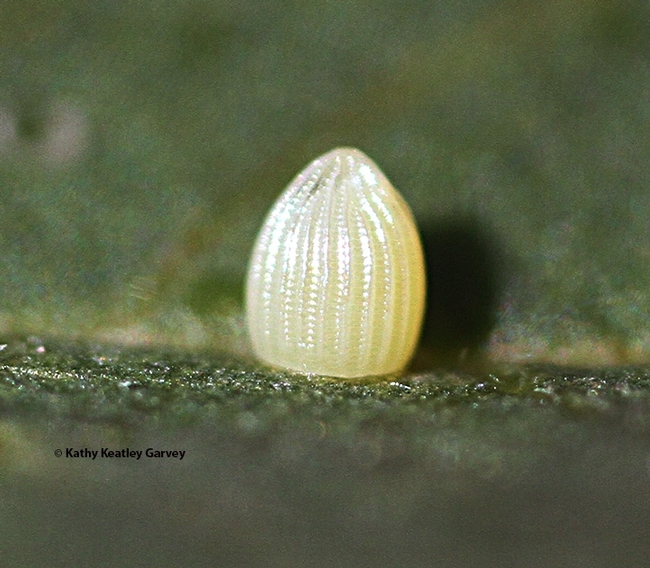
- Author: Kathy Keatley Garvey
Lady beetles, aka ladybugs, are not the only insects that feed on aphids.
So do the soldier beetles, family Cantharidae. They are sometimes known as leatherwings.
Got roses?
Got aphids?
You may also have a good friend, the soldier beetle.
Wikipedia tells us that their color pattern is reminiscent of the red coats of early British soldiers.
True.
